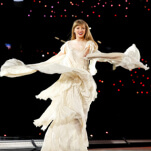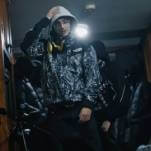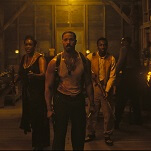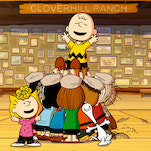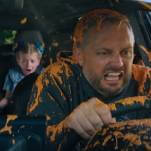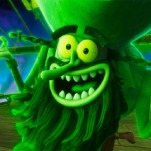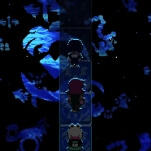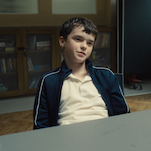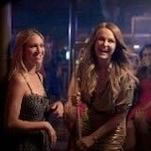Doctor Who (Classic): “The Talons of Weng-Chiang”
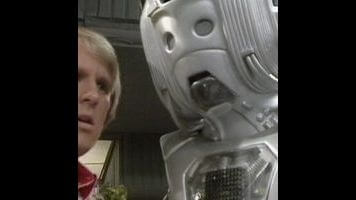
"The Talons of Weng-Chiang" (season 14, episodes 21-27. Originally aired Feb. 27- April 2, 1977)
Victorian London has such a longstanding appeal as a fictional setting that it's a little surprising that Doctor Who dropped in on the era only once, in 1966's "Evil of the Daleks," before taking a full-fledged romp through the city of gaslights and horse-drawn coaches in season 14's "Talons of Weng-Chiang." But the delay turned out to be a good thing, because there's no era of Who better suited for a Victorian tale than the horror-tinged, homage-happy sci-fi gothic period of the early Fourth Doctor years. Just as Alan Moore did in the comics with The League of Extraordinary Gentlemen, "Talons" gleefully pillages the vast storehouse of Victorian adventure fiction to create a dark, moody synthesis of its own. It's suffused with atmospheric details, and is one of the best serials the show ever did. If it wasn't for the uncomfortably racist aspects of the story, it'd be close to perfection.
It's also a long story at six episodes, so I'll just briefly run through the basics of the plot, to lay the groundwork for the rest of my thoughts about the story: The Doctor and his companion Leela arrive in fogbound London as tourists, intending to take in a show at the Palace Theater, but wind up instead tracking down a serial killer who's connected to a mysteriously powerful Chinese magician, Li H'sen Chang, and his sinister ventriloquist's dummy Mr. Sin. Assisting them are a couple of affably naive Victorian gentlemen, the raffish theater owner Henry Gordon Jago and the serious but soft-spoken coroner Dr. Litefoot. The killer is pretending to be Weng-Chiang, the so-called "Chinese god of abundance," and his powers seem to include the ability to create gigantic carnivorous rats, to grant Chang the ability to hypnotize people, and to give Mr. Sin the ability to move and think on his own. But these are all tricks: The killer is not Weng-Chiang but a fugitive Icelandic war criminal from the far future named Magnus Greel, whose escape in an experimental time machine left him horrifyingly disfigured and in constant need of fresh victims to replenish his failing DNA. Greel is only pretending to be Chinese because he happened to land there when he fled from his own time, a masquerade that is kept up largely as a means of ensuring the loyalty of Li H'Sen Chang, who worships him as a deity come to Earth. Greel and Chang are in London in search of his missing time machine, which turns out to be (in a bit of slightly undercooked narrative convenience) a family heirloom of Litefoot's. And it's become dangerously unstable, so if Greel does find it and try to use it, he might blow up most of London.
"Talons" is the last story of season 14, the end of Who's most consistently great era, led by producer Philip Hinchcliffe and script editor (and in this case, scriptwriter) Robert Holmes. After three years, Hinchcliffe was leaving, partly because of complaints from morality watchdogs about the violence during his run. Holmes would also step down midway through the next season, though he'd return now and again as a scriptwriter. Hinchcliffe clearly wanted to go out on a high note, and one reason "Talons" stands out is that since it was his last stand, he was eager to go for broke—in story terms and in the budget, supposedly spending money so freely that his production unit manager, the guy responsible for balancing the books, quit his job out of frustration. So the show looks great—'70s-British-TV great, anyway. It got the expensive night shoots it needed for atmosphere, as well as opulent set design, particularly Greel's final lair, dominated by its giant golden dragon.
Doctor Who quite commonly used older stories and genre trappings as spinning-off points for its own narrative, and never as consciously or as often as during the Hinchcliffe era. It had also, by this time, hit on the "pseudohistorical" to tell stories set in the past in a way more conducive to Who's blend of sci-fi/horror/fantasy than earlier historicals of the 1960s like "The Aztecs" or "The Romans," which were relatively grounded by the real events and people they depicted. "Talons" is perhaps the apotheosis of these two trends, because even though it's superficially a historical by virtue of its Victorian setting, it's not really concerned at all with accurately depicting real life in London in the late 1800s—instead, just as "The Brain of Morbius" was a trip to a planet where tropes from Universal and Hammer horror movies roamed the landscape, "Talons" weaves the essence of Doctor Who-style science fiction into a tapestry made of threads picked up from classic Victorian-era pulp adventure and crime fiction. In other words, it's not set in the Victorian London of history, but the Victorian London of story.
It's worth running through the major homages in play here, because talking my way through them also touches on nearly every important aspect of the story. Let's start with Magnus Greel, who is supposed to be masquerading as a Chinese god, but in practice is a melange of three considerably more European sources. His murder spree is a pretty obvious nod to Jack the Ripper, whose six still-unsolved slayings in 1888 made him a macabre legend, and helped popularize the concept of the serial killer. Like the Ripper, Greel's killings have a disturbing sexual undercurrent: He preferentially preys on young, nubile women, and there's something perverse about Greel's heavy breathing as he slouches behind the vaguely phallic machine that lets him feed on his victims' energy. Draining the life of others to keep his own twisted body functioning also associates Greel with the king of Victorian vampires, Dracula—which is probably also why he's got talons, come to think of it. And The Phantom Of The Opera, particularly Lon Chaney's 1925 silent-movie adaptation, gives Greel his mask, his hideously scarred face, and his role as a conniving lurker beneath the Palace Theater who terrorizes and preys on those above.
Greel also has a lot in common with the title villain of season 13's "The Brain of Morbius," another fugitive war criminal turned into a horrifying biological freak who's forced to trust his life to an underling he clearly has grown to loathe, and whose character is a patchwork of postmodernist references to characters from other stories—and who is also played by actor Michael Spice. Robert Holmes also wrote both those scripts, and he'd also played around with variations on that basic character type throughout his tenure as script editor. Greel and Morbius are both prime examples of the Hinchcliffe-era's reliance on what I think of as their "broken boss" motif, in which the ultimate foe of a particular story turns out to be a powerful, even godlike, evil being whose main goal was to heal itself of injuries that had devastated it before the story began, or at least to grow to its full strength before launching its final apocalyptic assault. Who had done this before Hinchcliffe in "The Three Doctors," and H.P. Lovecraft had toyed with it much earlier in "The Dunwich Horror" and "The Call of Cthulhu," but it became a Hinchcliffe/Holmes hallmark that also helped shape the plots of its best shows—"Talons" and "Morbius," and also "The Deadly Assassin," "Pyramids of Mars," "The Hand of Fear," and "The Seeds of Doom." (A couple years later, Douglas Adams would also use it to great effect in "City Of Death.") Put like that, it sounds suspiciously like recycling the same idea over and over, but the real power of a story lies in how all the various aspects come together, and the broken-boss motif was always just one element of many.
The Doctor's role in the story is much easier to deconstruct: He's Sherlock Holmes. That's always been an influence on the Doctor's character, especially Tom Baker's Fourth Doctor, but he's particularly Sherlockian in attitude and even costume here, replacing his usual long scarf with the deerstalker and Inverness cape that symbolize his predecessor, and the murder mystery he finds himself embroiled in makes that association even stronger. Like Sherlock, Baker's Doctor is charming, aloof, eccentric, arrogant, prone to making brilliant deductive leaps, and disdainfully smarter than everyone else in the story—which is made easier for him because he's also the only one who knows the real story behind Magnus Greel, and thus is the only one who could ever have solved the mystery. Also like Sherlock, his aloofness is periodically broken by wild, unpredictable mood swings that burst out with startling ferocity, hinting that there was even more lurking under the surface than you could see. That was also one of the driving elements behind the increasing hints during this era that the Doctor was more than merely just a brilliant but weird man who'd stolen a time machine, but a kind of superhero or time-wizard—as he poetically put it in "Pyramids Of Mars," "I'm a Time Lord; I walk in eternity." This was a natural progression for the character, and would be expanded in the late 1980s in the Seventh Doctor era and again in the current series. And it's easy to see why, because the concept is really entertaining and fun when it's handled right, and one of the main reasons why Doctor Who has lasted as long as it has. It's also got its problems. Having a main character as powerful as the current-era Doctor just magnifies the lamentable tendency of Russell T. Davies' stories toward wildly overwrought ridiculousness and handwaving magical solutions, and Steven Moffatt's toward Byzantine overcomplexity and handwaving magical solutions. All that started in earnest here, in the early Tom Baker seasons.
Both the Doctor and Greel are moody and mysterious figures who hold power over the story in part because you don't know what they're going to do next, and cultivating that sense of mystery (and making sure there's enough plot to stretch over six episodes) means keeping the two primary antagonists at a distance from each other as long as possible. That means that "Talons" relies on its secondary characters—Leela, Litefoot and Jago—to be its audience-identification figures. I'll get to Leela in a moment, but since I just brought up Sherlock Holmes, this is a good place to talk about the two bumbling but loveable sidekicks. Jago and Litefoot are a textbook example of another of Robert Holmes' pet motifs, the comic double-act, which shows up repeatedly in his scripts—Irongron and his henchman Bloodaxe in "The Time Warrior" and the two thieves in "The Ribos Operation" are other examples. The unusual thing about Jago and Litefoot is that they don't actually meet until halfway into the fifth episode, spending the early episodes instead separately playing Dr. Watson to the Doctor's Holmes. Which is a clever way of commenting on Watson's uniquely bipolar-seeming persona in popular culture, and the two very different Watsons that have competed for attention in the vast collection of Sherlockian fiction that's grown up over the last 100 years. The original Conan Doyle character is a competent physician and a brave but humble and gentlemanly friend. But there's also a Watson who is a pompous, blithering comic fool, popularized by actor Nigel Bruce in the 1930s and '40s movies starring Basil Rathbone. With Litefoot in the role of the first Watson and Jago in the second, "Talons" gets to have it both ways. Once they do meet, of course, they click immediately. They're a great team: Jago's ebullience, bluster and cowardice is nicely balanced by Litefoot's soft-spoken, level-headed bravery, and they share an endearing semi-competence and a well-meaning, naive eagerness to be Victorian gentlemen-heroes in the best sense of that term. They're like a couple of overgrown boys. It's so much fun to see them get in over their heads against Greel that I'd almost rather have seen the story stick to them as the main characters, never mind whether the Doctor came back to save the day. And that chemistry didn't go unnoticed at the time the show was made, given that there was talk of a spinoff show that Robert Holmes apparently never had the time or energy to pursue. But hey, if suitable actors could be found to recreate the roles today, wouldn't it be great to see them running around Victorian London solving crimes with Madame Vastra and Jenny from "A Good Man Goes To War"?




